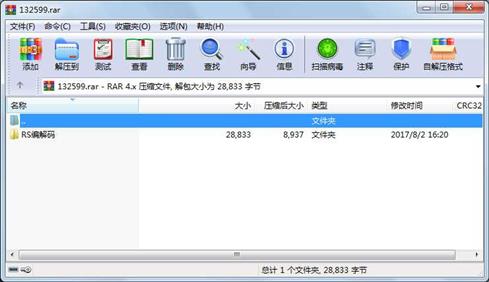资源简介
RS编解码的通用实现

代码片段和文件信息
#include “rs.h“
void encode_rs(int recd[nn] int data[kk] int bb[nn-kk])
/* take the string of symbols in data[i] i=0..(k-1) and encode systematically
to produce 2*tt parity symbols in bb[0]..bb[2*tt-1]
data[] is input and bb[] is output in polynomial form.
Encoding is done by using a feedback shift register with appropriate
connections specified by the elements of gg[] which was generated above.
Codeword is c(X) = data(X)*X**(nn-kk)+ b(X) */
{
int ij ;
int feedback ;
for (i=0; i
for (i=kk-1; i>=0; i--)
{
feedback = index_of[data[i]^bb[nn-kk-1]] ;
if (feedback != -1)
{
for (j=nn-kk-1; j>0; j--)
if (gg[j] != -1)
bb[j] = bb[j-1]^alpha_to[(gg[j]+feedback)%nn] ;
else
bb[j] = bb[j-1] ;
bb[0] = alpha_to[(gg[0]+feedback)%nn] ;
}
else
{
for (j=nn-kk-1; j>0; j--)
bb[j] = bb[j-1] ;
bb[0] = 0 ;
} ;
} ;
for (i=0; i
for (i=0; i
}
void decode_rs(int recd[nn] int dataout[kk])
/* assume we have received bits grouped into mm-bit symbols in recd[i]
i=0..(nn-1) and recd[i] is index form (ie as powers of alpha).
We first compute the 2*tt syndromes by substituting alpha**i into rec(X) and
evaluating storing the syndromes in s[i] i=1..2tt (leave s[0] zero) .
Then we use the Berlekamp iteration to find the error location polynomial
elp[i]. If the degree of the elp is >tt we cannot correct all the errors
and hence just put out the information symbols uncorrected. If the degree of
elp is <=tt we substitute alpha**i i=1..n into the elp to get the roots
hence the inverse roots the error location numbers. If the number of errors
located does not equal the degree of the elp we have more than tt errors
and cannot correct them. Otherwise we then solve for the error value at
the error location and correct the error. The procedure is that found in
Lin and Costello. For the cases where the number of errors is known to be too
large to correct the information symbols as received are output (the
advantage of systematic encoding is that hopefully some of the information
symbols will be okay and that if we are in luck the errors are in the
parity part of the transmitted codeword). Of course these insoluble cases
can be returned as error flags to the calling routine if desired. */
{
int ijuq ;
int elp[nn-kk+2][nn-kk] d[nn-kk+2] l[nn-kk+2] u_lu[nn-kk+2] s[nn-kk+1] ;
int count=0 syn_error=0 root[tt] loc[tt] z[tt+1] err[nn] reg[tt+1] ;
/* first form the syndromes */
for (i=1; i<=nn-kk; i++)
{
s[i] = 0 ;
for (j=0; j
s[i] ^= alpha_to[(recd[j]+i*j)%nn] ; /* recd[j] in index form */
/* convert syndrome from polynomial form to index form */
if (s[i]!=0) syn_error=1 ; /* set flag if non-zero syndrome => error */
s[i] = index_of[s[i]] ;
} ;
if (syn_error) /* if errors try and co属性 大小 日期 时间 名称
----------- --------- ---------- ----- ----
文件 9507 2014-06-18 08:55 RS编解码\rs.cpp
文件 876 2014-06-18 08:54 RS编解码\rs.h
文件 17839 2017-07-18 10:03 RS编解码\RScode1.txt
文件 611 2014-06-18 08:54 RS编解码\test_rs.cpp
目录 0 2017-08-02 16:20 RS编解码
----------- --------- ---------- ----- ----
28833 5
相关资源
- 操作系统c语言模拟文件管理系统844
- C语言开发实战宝典
- C++中头文件与源文件的作用详解
- C语言代码高亮html输出工具
- 猜数字游戏 c语言代码
- C语言课程设计
- 数字电位器C语言程序
- CCS FFT c语言算法
- 使用C语言编写的病房管理系统
- 通信过程中的RS编译码程序(c语言)
- 计算机二级C语言上机填空,改错,编
- 用回溯法解决八皇后问题C语言实现
- 简易教务管理系统c语言开发文档
- 操作系统课设 读写者问题 c语言实现
- 小波变换算法 c语言版
- C流程图生成器,用C语言代码 生成C语
- 3des加密算法C语言实现
- 简单的C语言点对点聊天程序
- 单片机c语言源程序(51定时器 八个按
- 个人日常财务管理系统(C语言)
- c语言电子商务系统
- 小甲鱼C语言课件 源代码
- 将图片转换为C语言数组的程序
- C语言实现的一个内存泄漏检测程序
- DES加密算法C语言实现
- LINUX下命令行界面的C语言细胞游戏
- 用单片机控制蜂鸣器播放旋律程序(
- 学校超市选址问题(数据结构C语言版
- 电子时钟 有C语言程序,PROTEUS仿真图
- 尚观培训linux许巍老师关于c语言的课
 川公网安备 51152502000135号
川公网安备 51152502000135号
评论
共有 条评论